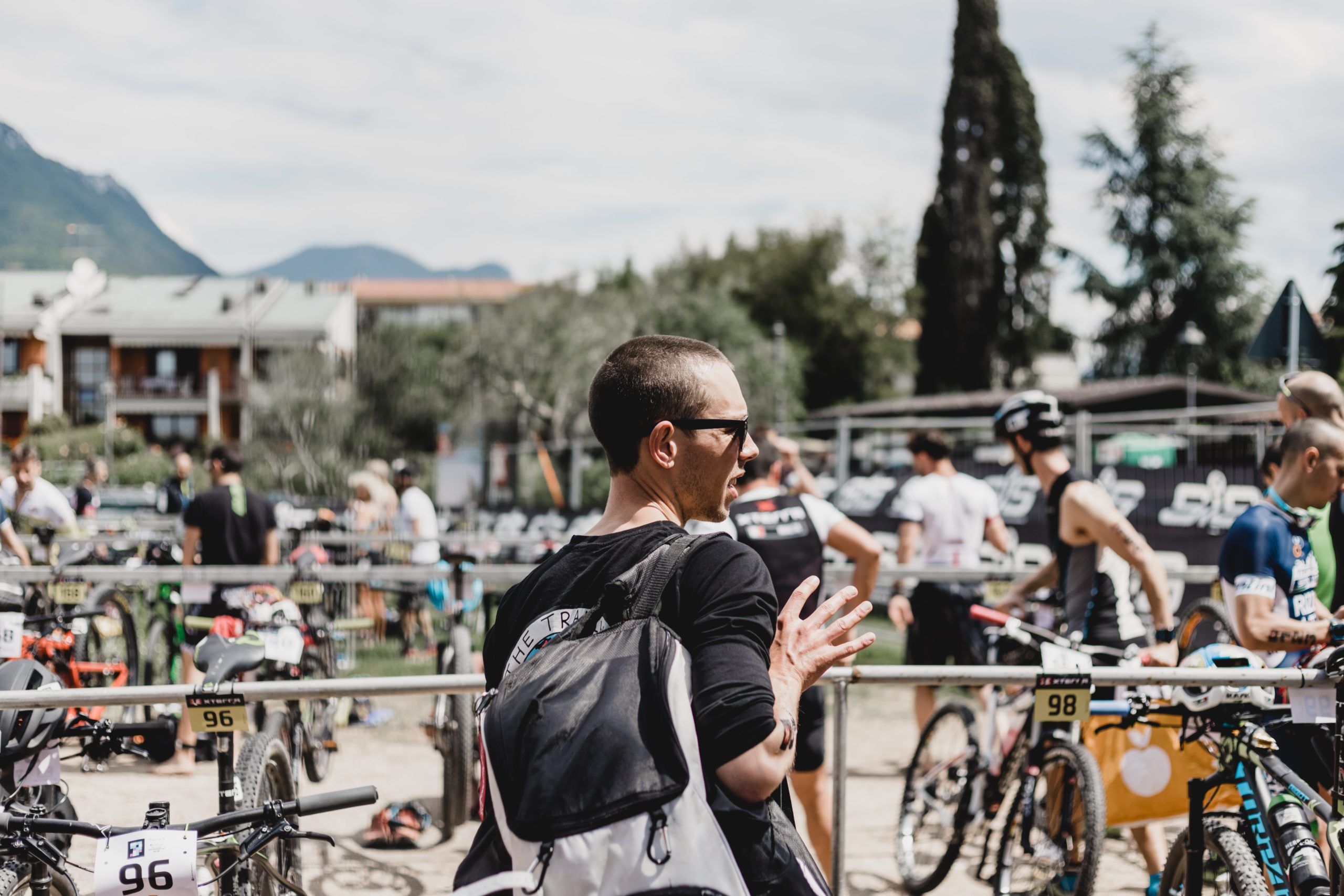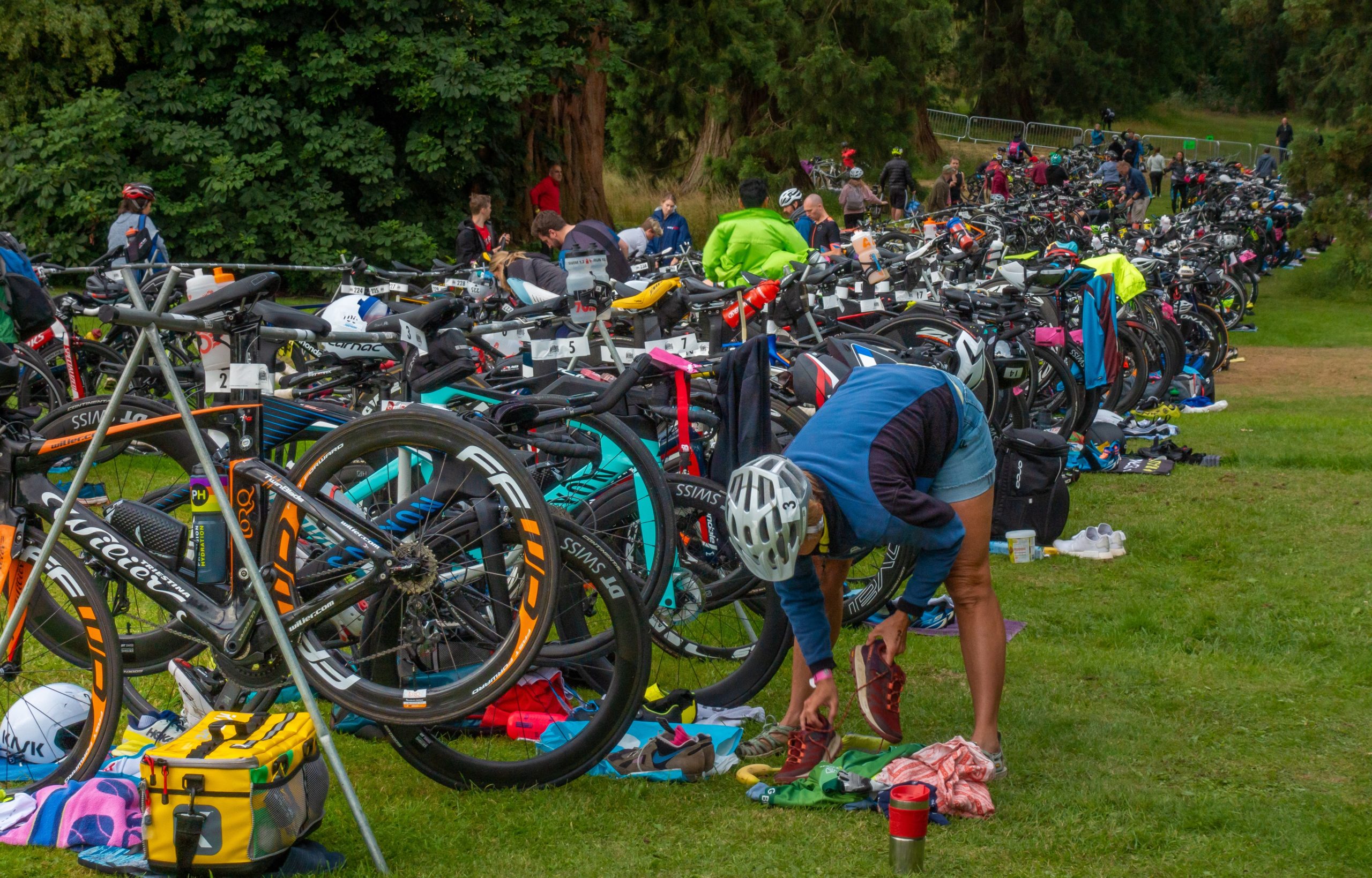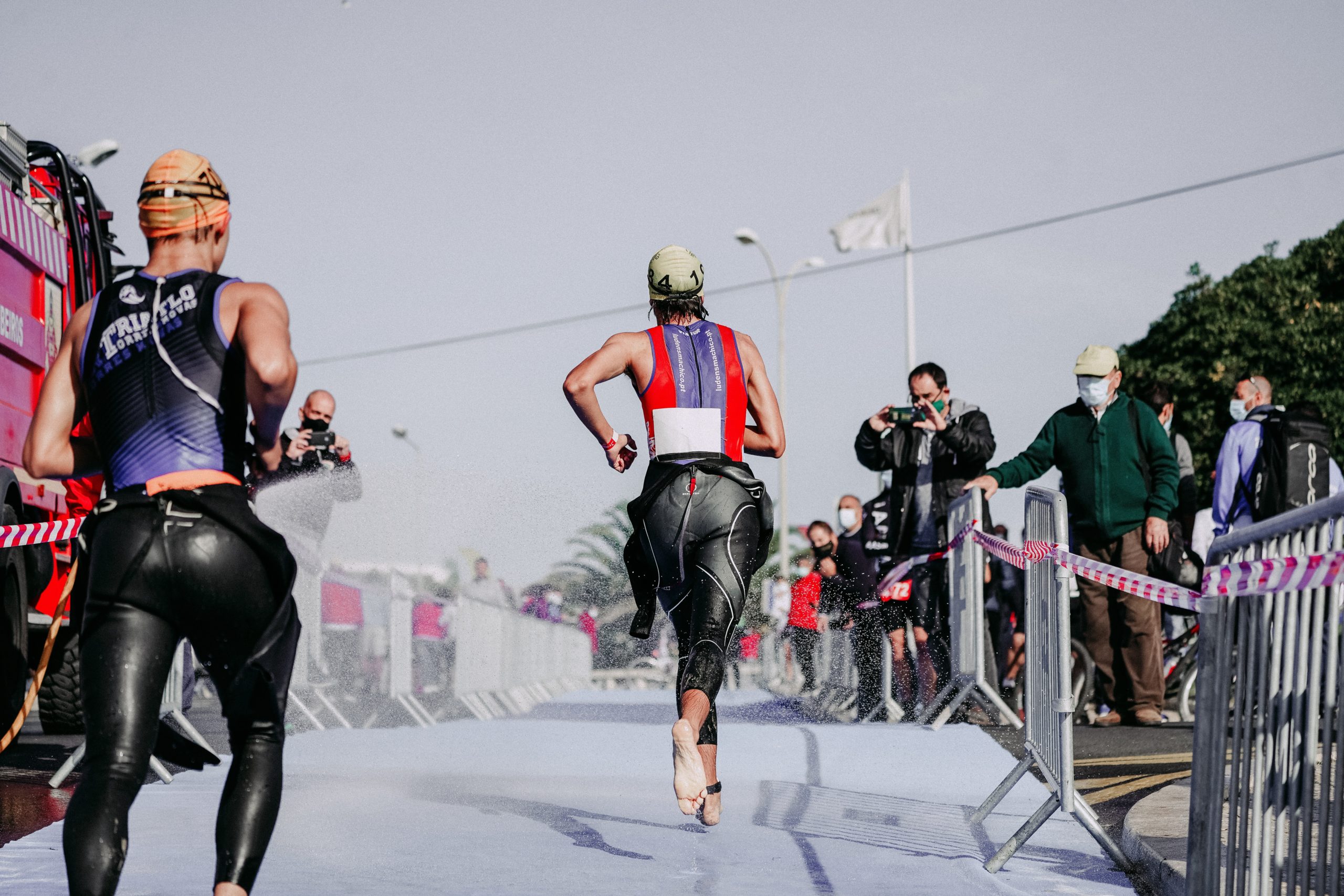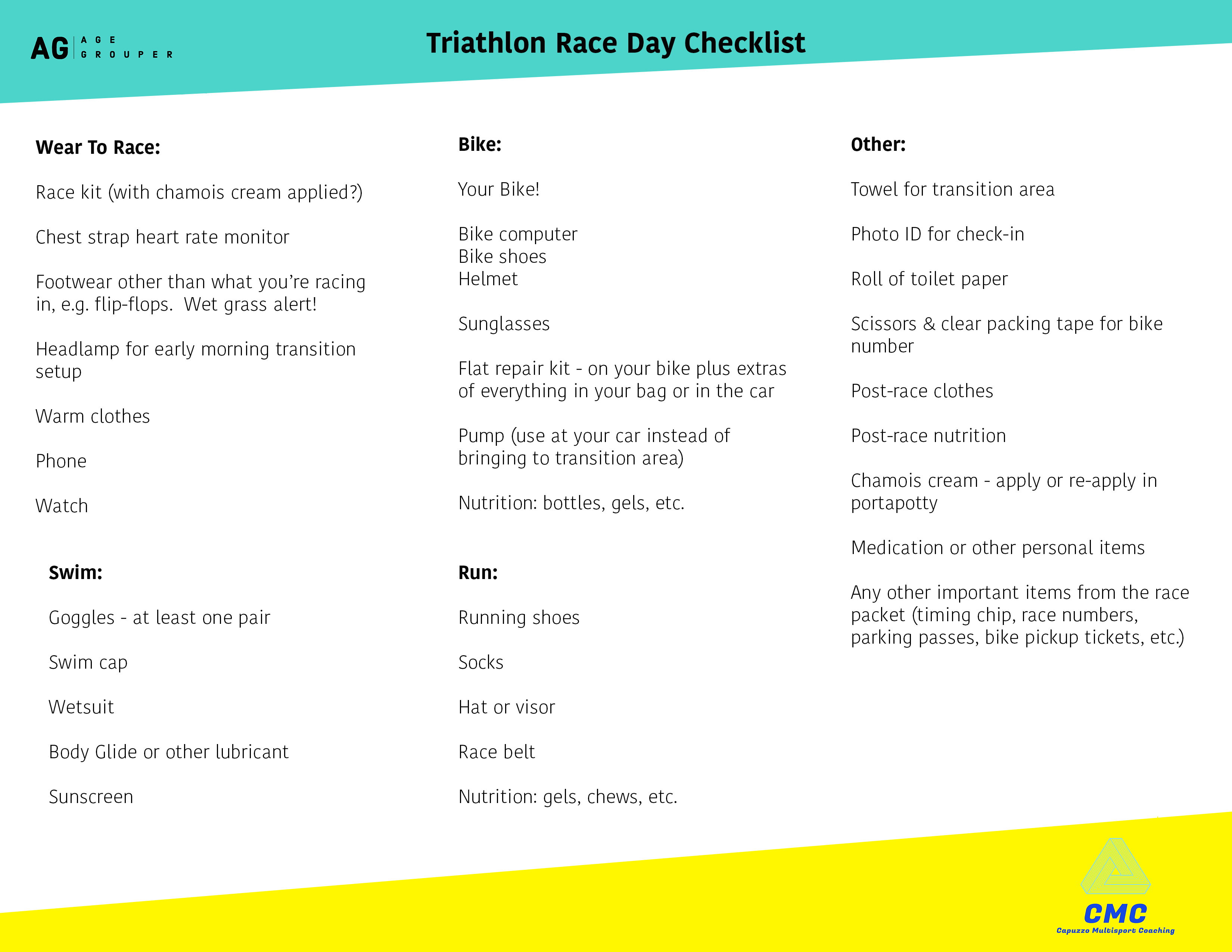Nailing Transitions in Your Next Triathlon
Set your triathlon transition game up for success: minimize time and maximize performance on race day.

It’s hard to imagine a more intense situation than running into the transition area of a triathlon. Your heart rate is through the roof, there are tons of spectators and the clock is ticking. You’re trying to get your bearings (hey, when did the sun come up?!?) and get in and out as quickly as possible. So what can you do to streamline your process and avoid the pratfalls and foibles that plague so many beginners?
What the Heck is a “Transition” in Triathlon?
For those new to the sport of triathlon, the concept of transitions can seem a bit foreign. In what other world are you timed by how fast you can put on your shoes?
“Transition” refers to the stage of the race where the athlete will switch from one discipline to another. It is made up of two sections, transition one (T1) where the athlete will switch from swimming to biking, and transition two (T2) where the switch is from biking to running.
T1- The primary focus here is for the athlete to get their wetsuit or swimming attire off, their helmet on and grab any accouterments they will need for the bike leg. The timer starts once the athlete enters the transition area and ends once they cross the “Bike Mount” line. Note: you are NOT allowed to get on your bike until after you’ve crossed this line.
T2- Similar to the start of the bike, when you approach T2 there is a “Bike Dismount” line at which point you must be OFF your bike before crossing. Once into transition, the focus is to get your bike back on the rack, put your running shoes on and grab any items you’ll need for the run.

Setting Up Transition, The Calm Before the Storm
Get to your race early so that you have plenty of time to set up and get the lay of the land. Race morning is inherently stressful; don’t compound the stress by showing up so late that there’s barely any room left for you on the bike rack. Look around and find out where you’ll be entering and exiting transition after the swim and bike. Count the bike racks or note a landmark so you can find your bike easily when you run in from the water.
How should you lay out your transition area on race morning? Exactly how you laid it out earlier in the week! There are plenty of details to sweat here and many of them are matters of personal preference, so don’t risk anything by making these decisions in the pre-race pressure cooker.
Group your T1 items on your towel separately from T2 items, including grab-and-go nutrition like gels or chews. Put your bike in a gear with low resistance so it will be easy to get rolling once you’re out of T1. Invest in a top tube storage bag to hold any gels, bars or chews you might want on the bike. Orient your helmet on your handlebars so it’s not backwards when you flip it onto your head (been there, done that!) and stash your sunglasses inside your helmet. Have your bike computer turned on and in the right mode before you walk to the swim start. You remembered to charge it, right?
Be sure to leave yourself more time than you think you’ll need to get your wetsuit on. Lubricant is your friend! Apply it to your wrists and ankles so that your arms and legs will slide out easily in T1, and slather it onto the back of your neck so that the velcro at the top of your wetsuit zipper doesn’t chafe during the swim.
You may notice that some of your fellow competitors have their bike shoes already clipped into the pedals in transition. Here’s their plan: run out of T1 barefoot, hop onto the bike using a flying mount, pedal a few cranks with their feet on top of their shoes, and then put their feet into the shoes once the bike is rolling. A pro move for sure, and certainly not something to try for the first time on race day, but potentially a big time saver as long as you take a few precautions.
First and foremost, make sure that the ground in T1 is not so rocky that running across it barefoot will be painful or even worse, injurious. Use a rubber band to attach your crank to the chainstay on the non-drive side so that your shoes stay at the 9 o’clock and 3 o’clock position instead of dragging along the ground and potentially detaching from the pedal. Don’t worry, the rubber band will snap once you start pedaling. If all of this sounds too complicated, by all means run out of T1 with your bike shoes on and mount your bike from a standing position.

Out of the Water and Into T1
Your T1 time starts as soon as you’re out of the water and over the first timing mat, but don’t wait to start getting out of that wetsuit! Take the top half off as soon as you start running out of the water. If you’re wearing a full wetsuit, hold your goggles and swim cap in your hand as you pull your arm out of the sleeve and voila, they’ll stay in the sleeve until after the race. Once you get to your bike, no sitting down! Use the “stand and stomp” method to get your legs out.
Are you planning to put socks on those wet, sandy feet? For a shorter race, no socks might be the way to go as long as you’re not prone to blisters, but putting socks on for a longer distance triathlon is probably a wise investment of your time. In any event, leave a little extra real estate on your transition towel so you can wipe your feet upon arrival. Taking a second to toss your wetsuit over the bike rack once you’ve removed it is a win-win move for you and your neighbors. The same goes for your other items as well: do your best to keep them confined to your immediate area.
Per USAT rules, your helmet must be on AND buckled before you remove your bike from the rack and remain clipped until after it is back on the rack. Don’t forget this important detail – you could incur a time penalty or otherwise. Once that’s done, it’s out onto the bike course you go.

Born to Run: Tips for T2
As you ride towards the transition area at the end of the bike, it’s crucial to slow down and keep your eyes and ears open for instructions from race personnel. Whether you choose to dismount on the fly or come to a complete stop, you must be off of your bike prior to crossing the dismount line. Race officials are watching!
Additionally, you can be assessed a time penalty if your bike is not properly re-racked after your ride or if you are seen abandoning empty water bottles or gel packets in transition. While some disarray is inevitable in the hysteria of transition, do your best to play not just by USAT’s rules but the rules of common courtesy as well. A quick transition is no match for a four minute penalty!
So you managed to get your wetsuit off in T1… can you get your running shoes on in T2?
Speed laces are an inexpensive and indispensable hack. Have them set to the correct tension: not so tight that they won’t slip on easily, but not so loose that you’ll need to interrupt your run to bend over and make adjustments (hello, leg cramp).
Helmet off (aren’t you glad you put your sunglasses on under your helmet straps?) and onto your handlebars—hat or visor on. Save time by having your race number pre-attached to a race belt. Snap the belt on, grab your gels and run for the exit!
Nothing New on Race Day
It might be your first triathlon of the year (or career) but it shouldn’t be your first time going through your transitions. Lay everything out prior to race day and make sure everything you need is at the ready. Spice up your next brick workout by having your running shoes (and socks?) waiting by the door. Run out of the water like a maniac at your next open water practice swim and strip that wetsuit off as quickly as possible. If you’re having difficulty pulling your arms or legs out, consider cutting an inch or two off of the arms and legs of your wetsuit to increase the diameter of the openings.
Sure, every race will come with some surprises and discoveries, but don’t let one of them be that you stink at undoing a double knotted shoelace while hopping on one leg! With adequate planning and rehearsal, you can turn your transitions from an inefficient time sponge to a smooth, seamless asset on race day.
***
Paul Capuzzo is the founder and head coach of Capuzzo Multisport Coaching. After bringing a sizable metal stepladder to the transition area of his first triathlon in 2003, he has refined his process on his way to winning three sprint triathlons.


